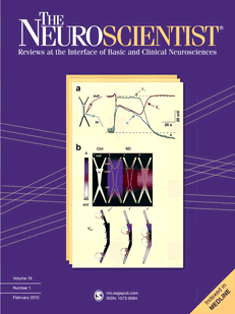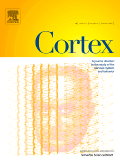
NEUROSCIENTIST
Scope & Guideline
Unveiling Innovations in Clinical Neurology
Introduction
Aims and Scopes
- Neurodevelopment and Neuroplasticity:
Research focusing on the development of the nervous system and the mechanisms of plasticity that allow the brain to adapt and reorganize in response to experience and injury. - Neurodegeneration and Neuroprotection:
Studies investigating the pathological processes underlying neurodegenerative diseases such as Alzheimer's and Parkinson's, along with potential therapeutic strategies for neuroprotection. - Neuroimmunology:
Exploration of the interactions between the nervous and immune systems, including the role of neuroinflammation in various neurological disorders. - Cognitive Neuroscience:
Research emphasizing the neural correlates of cognitive functions such as memory, learning, and decision-making, utilizing both human and animal models. - Behavioral Neuroscience:
Investigations into how neural mechanisms influence behavior, including the study of mood disorders, anxiety, and stress responses. - Translational Neuroscience:
Bridging laboratory findings with clinical applications, this area seeks to translate basic neuroscience discoveries into effective treatments for neurological and psychiatric disorders.
Trending and Emerging
- Neuroinflammation and Immune Response:
Increasing research focus on the role of neuroinflammation and the immune system in neurological diseases, particularly in the context of COVID-19 and its neurological implications. - Neurotechnology and Brain-Machine Interfaces:
A rising interest in neuroprosthetics and brain-computer interfaces, highlighting advancements in technology that facilitate interaction between the brain and external devices. - Gut-Brain Axis:
Emerging studies investigating the influence of gut microbiota on brain function and behavior, suggesting a critical link between gastrointestinal health and neurological outcomes. - Epigenetics and Neurodevelopment:
A growing trend in exploring how epigenetic mechanisms influence brain development and the risk of neurodevelopmental disorders, shedding light on environmental impacts on neural health. - Personalized Medicine in Neurology:
An increasing emphasis on personalized approaches to treatment, including the use of biomarkers and genetic profiling to tailor interventions for individuals with neurological disorders.
Declining or Waning
- Traditional Pharmacological Approaches:
Research focusing solely on classical pharmacological treatments for neurological disorders appears to be waning as more emphasis is placed on novel therapeutic strategies, including gene therapy and neuromodulation techniques. - Basic Mechanistic Studies in Isolation:
There is a noticeable decline in studies that explore basic mechanisms of neuronal function in isolation, as interdisciplinary approaches that integrate behavioral, genetic, and environmental factors gain traction. - Neuroscience and Education:
The intersection of neuroscience with educational practices has seen reduced attention, perhaps overshadowed by more clinical and translational research themes that emphasize direct applications to health and disease.
Similar Journals

EUROPEAN JOURNAL OF NEUROSCIENCE
Connecting Biology, Psychology, and Medical ScienceEuropean Journal of Neuroscience is a prestigious, peer-reviewed journal published by Wiley, dedicated to advancing our understanding of the complex field of neuroscience. With an impact factor that positions it in the Q2 category of general neuroscience, this journal serves as a vital platform for researchers and professionals working at the intersection of biology, psychology, and medical science. Since its inception in 1989, the journal has been committed to publishing high-quality research that spans various topics within neuroscience, thus facilitating the exchange of innovative ideas and methodologies. Despite being a subscription-based journal, it attracts a diverse readership and has achieved significant recognition, evidenced by its Scopus rank of 33 out of 113 in its field, placing it in the 71st percentile. The European Journal of Neuroscience not only fosters groundbreaking studies but also encourages collaboration among scholars, making it an indispensable resource for students, researchers, and professionals eager to stay informed about the latest scientific advancements.

NATURE REVIEWS NEUROSCIENCE
Connecting insights with groundbreaking research.NATURE REVIEWS NEUROSCIENCE is a prestigious journal published by NATURE PORTFOLIO, renowned for its commitment to advancing the field of neuroscience. Since its inception in 2000, it has become a significant platform for disseminating comprehensive reviews and insights that shape the understanding of neurological science. With an impressive Scopus ranking of #2 out of 113 in the General Neuroscience category, this journal consistently engages the top 2% of researchers and professionals in the field, underscoring its impactful contributions. The journal not only provides a forum for high-quality reviews but also bridges emerging research trends with established knowledge, fostering a robust discourse among scholars and practitioners. As a Q1 journal in Neuroscience (miscellaneous), NATURE REVIEWS NEUROSCIENCE offers invaluable access to critical research developments, making it an essential resource for students, researchers, and professionals aiming to stay at the forefront of neuroscience advancements. Explore the latest findings and engage with a global community dedicated to unraveling the complexities of the nervous system.

CORTEX
Unveiling Insights into Cognitive ProcessesCORTEX is a premier international journal published by Elsevier Masson, focusing on the cutting-edge areas of cognitive neuroscience, psychology, and neurology. With an impressive impact factor that places it in Q1 quartiles across multiple categories such as Cognitive Neuroscience and Neuropsychology, this journal serves as a vital resource for researchers, clinicians, and students alike. Established in 1964, CORTEX has continued to excel in disseminating high-quality scholarly work, offering insights that significantly enhance our understanding of the brain's functioning and behavior. Although not an open-access publication, it provides various access options to ensure the dissemination of knowledge is as wide-reaching as possible. As the field of cognitive psychology evolves, CORTEX remains at the forefront, fostering an environment for interdisciplinary collaboration and innovation. Researchers seeking to stay engaged with the latest advancements will find CORTEX an indispensable tool for their professional development.

Brain and Behavior
Advancing Knowledge in Behavioral Neuroscience.Brain and Behavior is a premier open-access journal published by WILEY, dedicated to advancing the field of Behavioral Neuroscience. With its ISSN 2162-3279, the journal has established itself as a vital resource for researchers, professionals, and students alike, fostering the dissemination of cutting-edge research since its inception in 2011. Renowned for its rigorous peer-review process, it enjoys a commendable Q2 ranking within the field, reflecting its impactful contributions and relevance in the scientific community. The journal not only emphasizes innovative studies that bridge behavioral science and neuroscience but also serves as a platform for diverse methodologies and interdisciplinary approaches. Accessible [open access](https://onlinelibrary.wiley.com/journal/21623279), Brain and Behavior invites submissions that explore the neural mechanisms underlying behavior, aiming to engage a global audience eager to expand the boundaries of knowledge in this dynamic field. Positioned in the heart of the United States, at 111 River St, Hoboken, NJ, it is strategically placed to collaborate with leading institutions and researchers worldwide.

SYNAPSE
Exploring the Depths of Neural CommunicationSYNAPSE, an esteemed journal in the field of Cellular and Molecular Neuroscience, is published by Wiley and serves as a vital platform for disseminating groundbreaking research in neuroscience. Established in 1987, this journal has been pivotal in exploring the intricate mechanisms governing synaptic function and neural communication, contributing to our understanding of the nervous system. With an ISSN of 0887-4476 and an E-ISSN of 1098-2396, SYNAPSE is indexed in Scopus and currently holds a Q4 quartile ranking in its category, reflecting its niche yet significant presence within the research community. Despite its recent ranking in the 21st percentile among its peers, the journal’s commitment to quality and innovation remains unwavering. It is published from Hoboken, New Jersey, and although it is not an open-access journal, it provides invaluable insights and critical reviews that are pivotal for researchers, professionals, and students alike who seek to advance their knowledge in the dynamic field of neuroscience. Join us in contributing to the ever-evolving discourse in cellular and molecular neuroscience through SYNAPSE.

TRENDS IN NEUROSCIENCES
Leading the Charge in Neuroscience InnovationTRENDS IN NEUROSCIENCES, published by CELL PRESS, is a leading journal in the field of neuroscience, offering cutting-edge insights and important developments in the rapidly evolving landscape of brain research. With an impressive Impact Factor and ranking in the top quartile (Q1) of the category for Neuroscience (miscellaneous), it is positioned as a vital resource for researchers and professionals seeking to stay abreast of the latest discoveries and trends from 1978 to the present. Specifically ranked #3 out of 113 in General Neuroscience by Scopus, this journal promotes the interdisciplinary exchange of ideas and knowledge, making it an essential platform for students and experienced scholars alike. Although it is not an Open Access journal, its value lies in its rigorous peer-review process and commitment to maintaining the highest standards of academic integrity. By continuing to explore the complexities of neural processes and behavior, TRENDS IN NEUROSCIENCES plays a crucial role in shaping the future of neuroscience research and education.

NEUROSCIENCE RESEARCH
Unveiling the Mysteries of the MindNEUROSCIENCE RESEARCH, published by Elsevier Ireland Ltd, is a leading journal in the field of neuroscience, with a notable reputation for disseminating high-quality research that spans a variety of topics within the discipline. With an ISSN of 0168-0102 and an E-ISSN of 1872-8111, this journal serves as a vital platform for both established researchers and emerging voices in the field. Ranking in the Q2 quartile in both Medicine and Neuroscience categories, it has been recognized as a reliable source of innovative findings since its inception in 1984, with continuous publication through 2024. Although it does not currently offer Open Access options, the journal is indexed in Scopus, holding a significant position at Rank #48/113 in General Neuroscience, reflecting its contribution to advancing the understanding of neural mechanisms across various contexts. With its address anchored in Ireland, NEUROSCIENCE RESEARCH plays an essential role in bridging scientific inquiry and practical applications, making it an indispensable resource for researchers, professionals, and students dedicated to the burgeoning field of neuroscience.

Frontiers in Systems Neuroscience
Empowering the global neuroscience community.Frontiers in Systems Neuroscience is a premier open-access journal published by FRONTIERS MEDIA SA, dedicated to advancing the understanding of the complex systems that underpin neural function and behavior. Established in 2007 and based in Switzerland, this journal has gained recognition for its rigorous peer-reviewed articles that contribute significantly to the fields of Cellular and Molecular Neuroscience, Cognitive Neuroscience, and Developmental Neuroscience. As of 2023, it proudly holds a Q2 ranking in several neuroscience categories, reflecting its high impact and relevance in the academic community. The journal is accessible to researchers, professionals, and students worldwide, providing a platform for innovative research while promoting collaborative scientific dialogue. With a commitment to open access, Frontiers in Systems Neuroscience ensures that groundbreaking findings are readily available to enhance knowledge sharing across the globe. This makes it an essential resource for anyone looking to stay at the forefront of neuroscience research.

JOURNAL OF COMPARATIVE NEUROLOGY
Illuminating the Complexity of Neural StructuresThe Journal of Comparative Neurology, published by Wiley, stands as a cornerstone in the field of neuroscience since its inception in 1911. With an ISSN of 0021-9967 and an E-ISSN of 1096-9861, this esteemed journal spans a comprehensive scope of comparative neuroanatomy, neurophysiology, and neural development, providing critical insights into the intricate workings of nervous systems across species. The journal has earned a prestigious Q2 ranking in the category of general neuroscience for 2023, showcasing its substantial impact, reflected in its Scopus ranking of #47 out of 113 journals in its field. Researchers and professionals examining evolutionary patterns, neural structure functions, and comparative studies will find this journal an invaluable resource. Although it does not provide open access, its rigorous peer-review process ensures the publication of high-quality research that is crucial for advancing knowledge in comparative neurobiology. With a commitment to fostering scholarly exchange, the Journal of Comparative Neurology remains dedicated to exploring the complexities of the nervous system through a comparative lens, making it a vital platform for the global neuroscience community.

ANNALS OF NEUROLOGY
Your Gateway to Cutting-Edge Neurology ResearchANNALS OF NEUROLOGY, published by Wiley, stands as a leading journal in the field of neurology, renowned for its rigorous peer-reviewed articles that contribute significantly to the understanding of neurological disorders and advances in clinical practices. With an impressive impact factor and ranked Q1 in both neurology and clinical neurology categories, this journal positions itself among the top repositories of cutting-edge research, indexed in Scopus with exemplary ranks in the 98th and 97th percentiles respectively. Since its inception in 1977 and with a commitment to excellence extending to 2024 and beyond, ANNALS OF NEUROLOGY aims to disseminate groundbreaking studies and foster dialogue within the academic community, making it an essential resource for researchers, healthcare professionals, and students dedicated to neurology. Although it does not currently offer open access, its accessibility through institutional subscriptions facilitates widespread scholarly engagement.